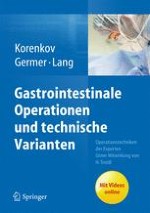2013 | OriginalPaper | Buchkapitel
3. Individualisierte Chirurgie bei Magen-GIST
verfasst von : Michael Korenkov, Prof. Dr. med., Christoph-Thomas Germer, Prof. Dr. med., Hauke Lang, Prof. Dr. med., Michel Gagner, Prof., Chandrajit Raut, Dr., Nicole J. Look Hong, Dr.
Erschienen in: Gastrointestinale Operationen und technische Varianten
Verlag: Springer Berlin Heidelberg











